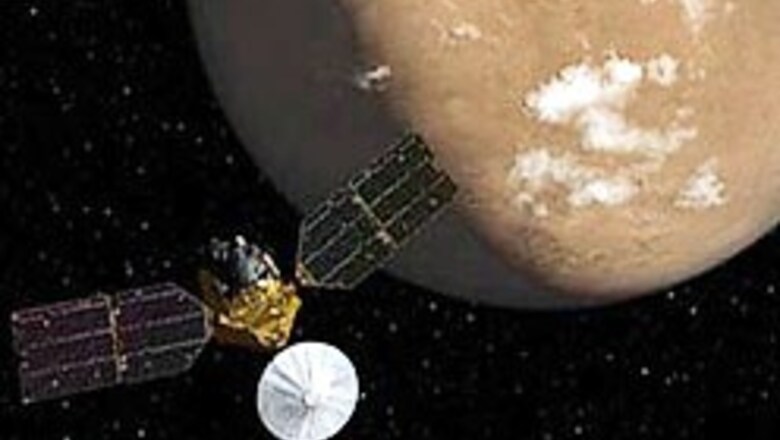
views
Cleveland (Ohio): NASA's latest mission to Mars could eclipse all previous ones if it can get into orbit on Friday.
The Mars Reconnaissance Orbiter will study the Martian atmosphere and surface, and will probe underground in search of past and present water.
But before it can collect data it has to slow down enough to get pulled into orbit -- a dangerous and tricky maneuver known as "orbit insertion."
And NASA is two for four in recent attempts.
"In the last 15 years NASA's lost two spacecraft out of four that they sent to the planet in this very phase ... getting into orbit is not easy," said MRO Project Manager Jim Graf.
If successful, the payoff could be great -- the MRO is expected to return more data to Earth than all previous Mars missions combined.
"I think that this mission will re-write the science books on Mars," Graf said.
"Every time that we send different spacecraft to Mars they teach and poke at the planet -- its atmosphere, at the surface and, in our case, under the surface and they solve mysteries," he said.
MRO launched on August 12 atop an Atlas V rocket from Cape Canaveral Air Force Station, Florida.
The $720 million mission is part of NASA's Mars Exploration Program, a series of spacecraft sent to the planet to establish ongoing surface and orbit observations of the planet's climate and geography.
It will join Mars rovers Spirit and Opportunity and fellow orbiters Mars Odyssey and Mars Global Surveyor and the European Space Agency's Mars Express.
The MRO carries six onboard instruments, including the most powerful telescopic camera ever flown to another planet.
With the spacecraft closing in on Mars it needs to fire its engines close enough to the planet in order to get captured by its gravity.
MRO project scientist, Rich Zurek says, "If there's a problem, we can't wait. We have to fix it and still be able to burn our engine" or the spacecraft will fly right on by the planet.
Sending and receiving commands is excruciatingly slow -- it takes 12 minutes for a signal from Earth to reach the orbiter.
MRO has to take care of itself using an onboard computer programmed to make course corrections and fire the engines at a preset time.
That engine burn is set for Friday at 1624 hrs ET (USA).
The palm sweating begins at 1550 hrs ET (USA) when the orbiter pressurizes its fuel to make the burn strong enough to put it into orbit.
MRO will then orient itself and fire its six main thrusters for 27 minutes.
About 20 minutes into the burn the spacecraft will disappear behind Mars and out of radio contact with mission control.
"We don't get to see the burn to the point where we know we're captured," Zurek said. Instead they must wait for MRO to come back around the planet and send a signal.
"You get to wait, you're hearing nothing, and then you get that moment," Zurek said.
"If the spacecraft is able to send us that signal, that means it's been working enough that were probably in orbit." The navigation team will confirm the craft is in orbit 30 to 45 minutes after the signal.
"We have done everything we can on this project to be able to assure ourselves the maximum chance of getting into orbit successfully... there's a lot of people with a tremendous amount of confidence right now, but that being said, I'm still worrying," Graf said.
Once MRO is in orbit, the team will begin the 6-month process of changing the craft's initial 35-hour orbit to one that can whip it around Mars in less then two hours -- optimal for scientific observation.
This orbit adjustment process is called "aerobreaking" -- a high-wire space act where MRO makes small dips into the Martian atmosphere and uses the drag on the craft to slow it down just enough to change its orbit.
It's a delicate balance: "You don't want to go too deep, because if you do then the friction will overheat the components on the spacecraft," Zurek said.
Scientific observation is slated to begin in November and take place over two years -- one Martian year.
MRO will act as both a geological explorer and weather satellite.
Two instruments will study the Martian atmosphere, looking at cloud formation and seasonal temperature change.
Zurek said, "The annual change on Mars is just like on the Earth, the seasons are pretty pronounced." The team wants to understand how long those seasons last. And how much water, and dust is moving around the atmosphere.
A powerful high-resolution camera will be able to see features on the planet as small as a kitchen table.
"We want to look for places where there was water for an extended period of time and potentially had an energy source, like a hot spring, because that's where you would expect life to have developed," Zurek said.
Italian Space Agency radar called SHARAD will probe a third of a mile below the surface for signs of water ice -- a big permafrost zone that may extend much deeper into the planet. Scientists suspect past water that was in the atmosphere might now be frozen deep underground.
The probe's sensors also will look for landing sites for future spacecraft including a manned mission to Mars.
Once observations are complete in December 2008 MRO will serve as a communications relay between future spacecraft and scientists back on Earth.
















Comments
0 comment